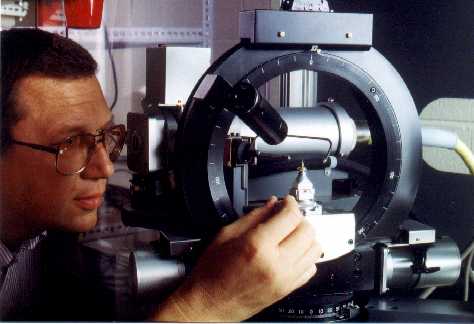

Our current efforts are directed toward a better understanding of the
correlation between the structural, theoretical and photophysical
properties of laser dye molecules, assemblies and polymorphs in three
classes structurally related to the coumarin, fluorene and methene
moieties, respectively. Our focus is being directed toward investigating
a theoretical approach to predicting crystal structures based on
systematically searching for densely packed structures within the common
planar organic species related to these laser dye cluster species. The
crystallographic data will serve as a starting point for these
investigations providing coordinates of the most stable cluster form
corresponding to the global minimum in the lattice energy. This will
ensure confidence that the most stable crystal structure will be found as
a model for the forces that bind the molecules together for a
crystal.
Based on our prior efforts and results with the coumarin based
molecules and clusters, we are moving in a new direction concentrating on
understanding the structural and theoretical nature of recently observed
polymorphism in coumarin related systems and in two new classes of laser
dye derivatives defined by the presence of the flourene and methene
structual units, respectively. Polymorphism in laser dye compounds was
first identified in our laboratory when we reported the polymorphic
crystalline structures of Coumarin 152 1 and Coumarin
138.2Within the past three years two additional polymorphic
species of coumarin compounds have been reported.3-7 It
would appear that additional members of the coumarin family of laser dye
compounds may also exhibit similar behavior. It is our aim to further
investigate these phenomena as well as search for similar effects in two
new classes of laser dye compounds and further relate these results to
crystal structure predictability. We have achieved some success in
studying two of the flourene based molecular assemblies in the crystalline
state. The single crystal structural analysis of Exalite 384 and Exalite
404 has been completed.8 By engaging in a coordinated
approach emphasizing both experimental and theoretical
fundamental techniques, we hope to provide a better understanding
of the photophysical processes that occur in these systems. Six
papers1,2,9-12, in the preparation stages and seven
presented papes have resulted from the work performed on this project in
our laboratory in the recent past. The proposed work includes the
development of a theoretical framework whereby one can probe the intra and
inter molecular nature of the interactions of these systems as well as
provide insight into the nature of the various discriminatory and
conformational energies that they tend to display. A potential outcome of
this effort may aid in the methodology of the possible design and
implementation of additional new types of laser dye materials.
For additional research information browse